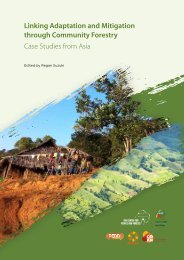Desktop Study on - Regional Climate Change Adaptation ...
Desktop Study on - Regional Climate Change Adaptation ...
Desktop Study on - Regional Climate Change Adaptation ...
Create successful ePaper yourself
Turn your PDF publications into a flip-book with our unique Google optimized e-Paper software.
Assessment of Capacity Gaps and Needs of South East Asia Countries<br />
in Addressing Impacts, Vulnerability and Adaptati<strong>on</strong> to <strong>Climate</strong> Variability and <strong>Climate</strong> <strong>Change</strong><br />
populati<strong>on</strong>. <strong>Climate</strong> change has favorable impact<br />
<strong>on</strong> rice cultivati<strong>on</strong>, but it cannot cover the influence<br />
of extreme climate event and cause large porti<strong>on</strong><br />
of populati<strong>on</strong> to be vulnerable. In this case, many<br />
of those households in moderate risk group moved<br />
to high-risk group (Snidv<strong>on</strong>gs, 2006). According<br />
to sea level rice, Thailand has a high c<strong>on</strong>centrati<strong>on</strong><br />
of ec<strong>on</strong>omic activities as well as big cities near<br />
the coastal area, which makes the country more<br />
vulnerable to this impact.<br />
Managing climate risk and the use of measures to<br />
reduce their vulnerability is not new for farmers,<br />
specifically rice farmers, of the Southeast Asia<br />
regi<strong>on</strong>, as for Thailand. These measures are different<br />
depending <strong>on</strong> the specific c<strong>on</strong>diti<strong>on</strong>s that the<br />
communities are facing, such as climate hazards<br />
faced, physical and envir<strong>on</strong>mental c<strong>on</strong>straints,<br />
available technologies, social and ec<strong>on</strong>omic<br />
c<strong>on</strong>diti<strong>on</strong>, vitality of community instituti<strong>on</strong>s, market<br />
c<strong>on</strong>diti<strong>on</strong>s, and the priorities and objectives of the<br />
farm households. The results suggest a pattern that<br />
is shaped by the socio-ec<strong>on</strong>omic c<strong>on</strong>diti<strong>on</strong> of their<br />
community. Some of the measures are focused and<br />
appear because of climate risks, but others are<br />
implemented because of other c<strong>on</strong>cerns, but also<br />
reduce climate risks by increasing the resilience of<br />
farmers’ livelihoods external factors. They include<br />
measures that are implemented at the individual<br />
farm-level, the community-level, and the nati<strong>on</strong>al<br />
level (Snidv<strong>on</strong>gs, 2006).<br />
Farmers in Thailand lean their measures <strong>on</strong>: (i)<br />
nati<strong>on</strong>al level; and (ii) household level, which is<br />
focused <strong>on</strong> income diversificati<strong>on</strong>, from alternative<br />
sources that are not as sensitive to climate variati<strong>on</strong>s.<br />
The main practice is seas<strong>on</strong>al migrati<strong>on</strong> to work in<br />
the cities, in order to secure fixed income for the<br />
household due to the fact that salary income from<br />
city employment is less sensitive to climate. Seas<strong>on</strong>al<br />
and permanent migrati<strong>on</strong> to diversify and support<br />
household incomes is made possible by close links<br />
between the rural villages and urban areas where<br />
there is demand for labour (Snidv<strong>on</strong>gs, 2006).<br />
The measures that the BMA report c<strong>on</strong>tains related<br />
with sea level rise in Bangkok, especially in Bang<br />
Khuntien District, refer to land use planning,<br />
c<strong>on</strong>structi<strong>on</strong> or improvement of levees and dykes,<br />
water reservoirs and waste discharge designs, coastal<br />
protecti<strong>on</strong> phased retreat, harbour/port operati<strong>on</strong><br />
and engineering for business and commercial, and<br />
ecosystem protecti<strong>on</strong> (BMA et al. 2009)<br />
Gaps Identified in Programmes and<br />
Studies<br />
In Thailand, as a developing country, is very<br />
focused <strong>on</strong> development c<strong>on</strong>cerns such as poverty<br />
alleviati<strong>on</strong>, ec<strong>on</strong>omic growth and envir<strong>on</strong>mental<br />
degradati<strong>on</strong>, given little less attenti<strong>on</strong> to the issue<br />
of climate change. But, climate change is str<strong>on</strong>gly<br />
linked with ec<strong>on</strong>omic activities central in modern<br />
societies: energy producti<strong>on</strong> and c<strong>on</strong>sumpti<strong>on</strong>,<br />
transportati<strong>on</strong>, and so <strong>on</strong>. Therefore, it should not<br />
be dissociated from the fundamental c<strong>on</strong>cerns of<br />
human society, such as nati<strong>on</strong>al ec<strong>on</strong>omic planning,<br />
public administrati<strong>on</strong> and human development<br />
(Permpibul and Routray, 2009).<br />
Also, as has been seen in the studies reviewed, the<br />
role of community level measures has declined or<br />
been neglected for household level and nati<strong>on</strong>al<br />
level (Snidv<strong>on</strong>gs, 2006). Current resp<strong>on</strong>ses to<br />
extreme climatic events are viewed more as disaster<br />
preparedness and mitigati<strong>on</strong> opportunities rather<br />
than as warning signals of much needed l<strong>on</strong>g-term<br />
adaptati<strong>on</strong>. Existing climate change models do not<br />
provide c<strong>on</strong>clusive assessments of the associated<br />
impacts at local levels. Therefore, there is a need<br />
for a bottom-up approach to address the level of<br />
vulnerability to the existing and future impacts<br />
to improve adaptati<strong>on</strong> at local level in the l<strong>on</strong>gterm.<br />
Adaptati<strong>on</strong> is strengthening capacities of<br />
communities in the l<strong>on</strong>ger term, and is c<strong>on</strong>text<br />
specific; hence require an active and meaningful<br />
participati<strong>on</strong> of stakeholders (Permpibul and<br />
Routray, 2009).<br />
Furthermore, there is still a lack of baseline<br />
informati<strong>on</strong> to understand the interplay between<br />
natural and human systems (ec<strong>on</strong>omic and social<br />
issues) and a gap in informati<strong>on</strong> <strong>on</strong> changes in<br />
climate and human systems in different ecosystems<br />
and agro‐climatic systems. The human dimensi<strong>on</strong>,<br />
especially livelihood aspects and inter‐sectoral<br />
relati<strong>on</strong>ships have not been incorporated<br />
successfully <strong>on</strong> the nati<strong>on</strong>al scale assessment.<br />
Without this for designing and planning adaptati<strong>on</strong><br />
policies, strategies and programs, decisi<strong>on</strong>s <strong>on</strong><br />
adaptati<strong>on</strong> will stay uncertain and will not c<strong>on</strong>duct<br />
to effective results (MRC, 2009).<br />
Recent Projects regarding Socio-<br />
Ec<strong>on</strong>omic Aspects<br />
Thailand, because of the Kyoto Protocol, included the<br />
climate change issue in its 11th Nati<strong>on</strong>al Ec<strong>on</strong>omic<br />
and Social Development Plan, to be implemented<br />
between 2012 and 2016. On top of the Government’s<br />
efforts, some initiatives in combating climate change<br />
97

















